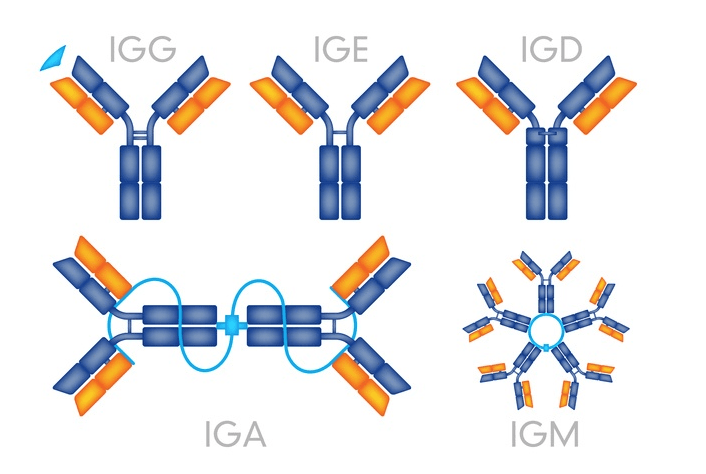Protein A vs Protein G, what is the difference? They are both bacterial cell wall proteins that have primary binding sites for mammalian immunoglobulin G (IgG) antibodies, including human IgG. Protein G was first isolated from Streptococcal bacteria strains C and G. Similarly, protein A was originally found on the cell wall of the bacteria Staphylococcus aureus. These proteins have primary binding domains for the Fc region of (IgG) antibodies, but can also recognize the Fab region of certain IgG subclasses described in more detail below.. For the bacteria this is useful because binding IgG’s at the Fc region prevents macrophages from recognizing them, which in turn prevents phagocytosis of the invading bacteria by the host immune system. For scientists this IgG binding can be used for probing in experiments such as purifications or immunoprecipitations.
Antibody structure and classes (isotypes)
There are 5 main classes of immunoglobulin antibodies: IgG, IgD, IgE, IgA, and IgM. They differ in the type of heavy chain and in their ability to join together to form higher order structures. The basic structure of an immunoglobulin is a Y-shape. The base of the Y is called the Fc region, while the two extensions of the Y are called the Fab regions. The Y itself is composed of two heavy chains and two light chains that are held together by a combination of non-covalent interactions and disulfide chains. The two tips of the Y are the variable regions where the antigen binding sites are located. This basic Y structure is usually the only form that IgG, IgD, and IgE antibody classes are found in. However, IgA can be a combination of two Y’s, and IgM is a pentamer.

Protein A vs Protein G: comparison between them
This ability of protein A and G to specifically recognize IgG antibodies makes them a useful tool. As such, they are often used commercially to purify IgG subtype antibodies or in biosensor development for the oriented immobilization of IgG’s to a sensor surface for antigen capture. Protein A and G are structurally very similar, but they have slightly different affinities for IgG subclasses across different species. These affinities overlap, but in general, protein A has greater affinity for rabbit, pig, dog, and cat IgG whereas protein G has greater affinity for mouse and human IgG. This, of course, is just a general guideline. Refer to affinity tables for detailed information for each IgG subclass in each species when carefully comparing protein A vs protein G for experimental design. When purchasing protein A vs protein G commercially, the specific binding characteristics of the protein will be in the available information.
Recombinant vs native IgG binding proteins
Native protein A and Protein G have albumin binding sites and cell wall binding regions in addition to IgG recognition sites. To prevent nonspecific binding of these proteins during bioassays, scientists have engineered recombinant protein A and G that lack the cell wall and albumin binding regions. These recombinant proteins are harvested from E. coli cultures. Recombinant protein A has 5 IgG binding domains, which is more than the native protein A. Therefore, recombinant protein A has increased affinity for IgG than native protein A. In addition, recombinant protein A/G has been developed. Protein A/G contains 4 protein A binding domains and two protein G binding domains, which broadens the subclasses of IgGs to which it has affinity.
Protein A vs Protein G experimental uses
When do scientists use protein A and G? One important example is co-immunoprecipitation(Co-IP). Co-IP is used to pull a protein out of solution while it is bound to its associated protein. The goal of a Co-IP is to learn about which proteins are associating or binding to other proteins. This method can be done very efficiently using magnetic beads pre-conjugated to protein A, protein G, or protein A/G. A primary antibody against a protein of interest is put into a protein mixture and given time to bind your protein. Then the solution can be mixed with the pre-conjugated magnetic beads. The antibody on your magnetic bead will bind the antibody in solution as well as your protein of interest and its binding partners. When isolated using a standard magnetic separation protocol, the protein and its partners can be eluted from the magnetic beads and analyzed on a gel. Protein A and protein G can also be used as labeled secondary antibodies in ELISA or western blotting experiments.
Related articles:






